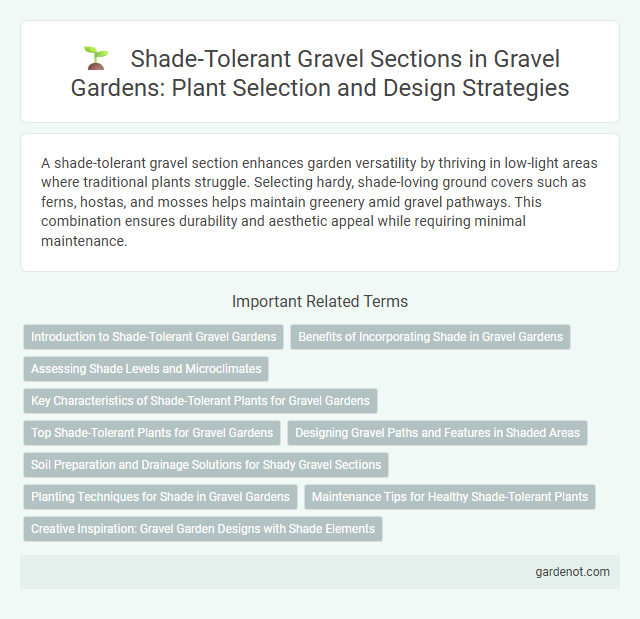A shade-tolerant gravel section enhances garden versatility by thriving in low-light areas where traditional plants struggle. Selecting hardy, shade-loving ground covers such as ferns, hostas, and mosses helps maintain greenery amid gravel pathways. This combination ensures durability and aesthetic appeal while requiring minimal maintenance.
Introduction to Shade-Tolerant Gravel Gardens
Shade-tolerant gravel gardens combine aesthetic appeal with low-maintenance landscaping solutions ideal for areas with limited sunlight. These gardens utilize drought-resistant plants such as hostas, ferns, and heucheras, which thrive in shaded conditions amid gravel mulch that enhances soil drainage and prevents erosion. Incorporating shade-tolerant species in gravel beds creates a sustainable, visually striking environment that conserves water and reduces garden upkeep.
Benefits of Incorporating Shade in Gravel Gardens
Incorporating shade in gravel gardens enhances moisture retention, reducing the need for frequent watering and promoting plant health in drier climates. Shade-tolerant plants such as ferns, hostas, and heucheras thrive in these conditions, adding texture and color diversity to the gravel landscape. This combination not only supports biodiversity but also creates a cooler microenvironment that can extend the growing season and reduce soil erosion.
Assessing Shade Levels and Microclimates
Assessing shade levels and microclimates is essential for designing a successful shade-tolerant gravel garden section, as plants like hostas, ferns, and heucheras thrive in low light conditions. Use tools such as light meters or observe daily sun patterns to determine the intensity and duration of shade, identifying areas of full shade, dappled shade, or partial shade. Microclimates created by surrounding structures, trees, or terrain influence moisture and temperature, affecting plant selection and gravel type for optimal growth and aesthetic balance.
Key Characteristics of Shade-Tolerant Plants for Gravel Gardens
Shade-tolerant plants for gravel gardens exhibit key characteristics such as low light requirements, efficient moisture retention, and adaptability to nutrient-poor soils. These plants typically have broad leaves or deep green foliage to maximize photosynthesis in shaded environments. Their root systems are often shallow yet resilient, ensuring survival in the well-drained, gritty substrate of gravel sections.
Top Shade-Tolerant Plants for Gravel Gardens
Top shade-tolerant plants for gravel gardens include Heuchera, Helleborus, and Tiarella, which thrive in low-light conditions while enhancing texture and color. Ferns such as Athyrium and Polystichum add lush greenery and adapt well to gravel substrates with poor drainage. These species require minimal maintenance, making them ideal for sustainable shade-tolerant gravel garden designs.
Designing Gravel Paths and Features in Shaded Areas
Shade-tolerant gravel sections enhance garden design by integrating gravel paths and features that thrive under limited sunlight. Selecting materials like decomposed granite or pea gravel combined with shade-loving plants such as hostas and ferns ensures durability and aesthetic appeal. Proper drainage and regular maintenance prevent moss growth and maintain the structural integrity of shaded gravel pathways.
Soil Preparation and Drainage Solutions for Shady Gravel Sections
Proper soil preparation in shade-tolerant gravel sections involves loosening compacted soil and incorporating organic matter to improve nutrient retention and moisture balance. Installing a well-designed drainage system, such as French drains or gravel layers with perforated pipes, prevents waterlogging in low-light areas prone to poor evaporation. Selecting soil amendments that enhance aeration and promote drainage ensures healthy root development for shade-loving plants in gravel gardens.
Planting Techniques for Shade in Gravel Gardens
Shade-tolerant gravel garden planting techniques emphasize selecting plants like hostas, ferns, and heucheras that thrive with minimal sunlight. Incorporating organic mulch beneath gravel improves moisture retention and soil fertility, supporting healthy root systems in shaded areas. Strategic layering of plants by height enhances microclimates and maximizes limited light for optimal growth in shade-dominant gravel sections.
Maintenance Tips for Healthy Shade-Tolerant Plants
To maintain a healthy shade-tolerant gravel garden section, regularly remove debris to prevent fungal growth and promote air circulation. Apply a balanced, slow-release fertilizer during the growing season to support plant nutrition without overwhelming the soil. Inspect plants frequently for signs of pests or disease, and prune dead or damaged foliage to encourage vigorous growth in low-light conditions.
Creative Inspiration: Gravel Garden Designs with Shade Elements
Shade-tolerant gravel garden designs incorporate plants like hostas, ferns, and Heuchera that thrive in low-light conditions, creating textured layers against angular gravel beds. Combining diverse leaf shapes and shades with natural stone elements enhances visual interest and promotes healthy root aeration. Using mulch and permeable gravel supports moisture retention and reduces soil erosion, optimizing plant growth in shaded garden sections.
Shade-tolerant gravel section Infographic

 gardenot.com
gardenot.com